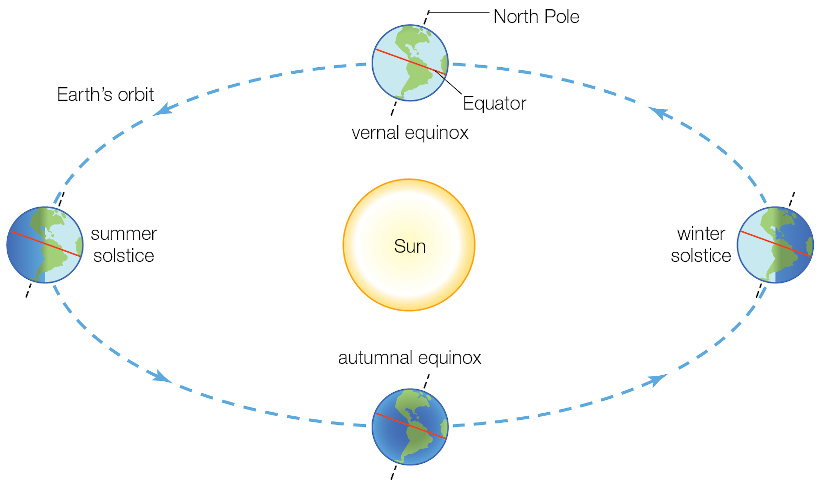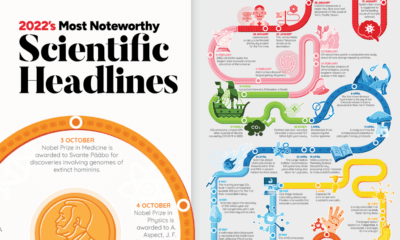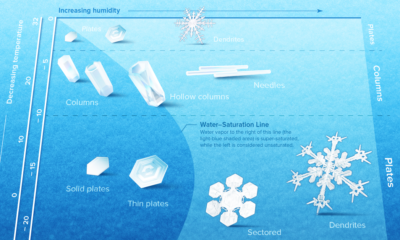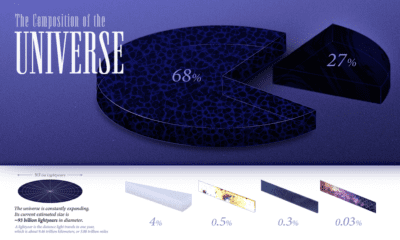These changing lengths of days and nights depend on where you are on Earth and the time of year. The tilt of the Earth’s axis and its path around the sun affect the number of daylight hours.
Today’s post highlights two simple and elegant animations that help demonstrate how different latitudes experience the sun’s light over the course of one year. The first comes from Reddit user harplass, while the second comes from data scientist Neil Kaye.
Longer and Shorter Days
The Ancient Greeks envisioned the movement of the sun as a Titan named Helios who rode across the sky in a horse-drawn chariot, illuminating the known world below. A rosy-fingered dawn would herald his imminent arrival, while the arrival of the dusk god Astraeus, ever on Helios’ heels, marked the passage of day into night. Today, time is not at the whims of Greek mythology but by the measurable and consistent movement of celestial bodies. A day on Earth is 24 hours long, but not every day has 12 hours of daylight and 12 hours of night. The actual time of one Earth rotation is a little shorter–about 23 hours and 56 minutes.
Daytime is shorter in winter than in summer, for each hemisphere. This is because the Earth’s imaginary axis isn’t straight up and down, it is tilted 23.5 degrees. The Earth’s movement around this axis causes the change between day and night. During summer in the Northern Hemisphere, daylight hours increase the farther north you go. The Arctic gets very little darkness at night. The seasonal changes in daylight hours are small near the Equator and more extreme close to the poles.
Length of a Rotation: Equinoxes and Solstices
There are four events that mark the passing stages of the sun, equinoxes and solstices. The two solstices happen June 20 or 21 and December 21 or 22. These are the days when the sun’s path in the sky is the farthest north or south from the Equator. A hemisphere’s winter solstice is the shortest day of the year and the summer solstice the year’s longest.
In the Northern Hemisphere the June solstice marks the start of summer: this is when the North Pole is tilted closest to the sun, and the sun’s rays are directly overhead at the Tropic of Cancer. The December solstice marks the start of winter when the South Pole is tilted closest to the sun, and the sun’s rays are directly overhead the Tropic of Capricorn. The equinoxes happen around March 21 and September 23. These are the days when the sun is exactly above the Equator, which makes day and night of equal length.
Stand in the Place Where You Are
It is always darkest before the dawn, and every passing of solstice marks a time of change. As the Northern Hemisphere heads into the winter holiday season, it also marks the advent of longer days and the inevitable spring and summer.
The lengths of days and nights are constantly changing, but every one will get their time in the sun, at some point.
on
#1: High Reliability
Nuclear power plants run 24/7 and are the most reliable source of sustainable energy. Nuclear electricity generation remains steady around the clock throughout the day, week, and year. Meanwhile, daily solar generation peaks in the afternoon when electricity demand is usually lower, and wind generation depends on wind speeds.As the use of variable solar and wind power increases globally, nuclear offers a stable and reliable backbone for a clean electricity grid.
#2: Clean Electricity
Nuclear reactors use fission to generate electricity without any greenhouse gas (GHG) emissions.Consequently, nuclear power is the cleanest energy source on a lifecycle basis, measured in CO2-equivalent emissions per gigawatt-hour (GWh) of electricity produced by a power plant over its lifetime. The lifecycle emissions from a typical nuclear power plant are 273 times lower than coal and 163 times lower than natural gas. Furthermore, nuclear is relatively less resource-intensive, allowing for lower supply chain emissions than wind and solar plants.
#3: Stable Affordability
Although nuclear plants can be expensive to build, they are cost-competitive in the long run. Most nuclear plants have an initial lifetime of around 40 years, after which they can continue operating with approved lifetime extensions. Nuclear plants with lifetime extensions are the cheapest sources of electricity in the United States, and 88 of the country’s 92 reactors have received approvals for 20-year extensions. Additionally, according to the World Nuclear Association, nuclear plants are relatively less susceptible to fuel price volatility than natural gas plants, allowing for stable costs of electricity generation.
#4: Energy Efficiency
Nuclear’s high energy return on investment (EROI) exemplifies its exceptional efficiency. EROI measures how many units of energy are returned for every unit invested in building and running a power plant, over its lifetime. According to a 2018 study by Weissbach et al., nuclear’s EROI is 75 units, making it the most efficient energy source by some distance, with hydropower ranking second at 35 units.
#5: Sustainable Innovation
New, advanced reactor designs are bypassing many of the difficulties faced by traditional nuclear plants, making nuclear power more accessible.
Small Modular Reactors (SMRs) are much smaller than conventional reactors and are modular—meaning that their components can be transported and assembled in different locations. Microreactors are smaller than SMRs and are designed to provide electricity in remote and small market areas. They can also serve as backup power sources during emergencies.
These reactor designs offer several advantages, including lower initial capital costs, portability, and increased scalability.
A Nuclear-Powered Future
Nuclear power is making a remarkable comeback as countries work to achieve climate goals and ultimately, a state of energy utopia. Besides the 423 reactors in operation worldwide, another 56 reactors are under construction, and at least 69 more are planned for construction. Some nations, like Japan, have also reversed their attitudes toward nuclear power, embracing it as a clean and reliable energy source for the future. CanAlaska is a leading exploration company in the Athabasca Basin, the Earth’s richest uranium depository. Click here to learn more now. In part 3 of the Road to Energy Utopia series, we explore the unique properties of uranium, the fuel that powers nuclear reactors.






























